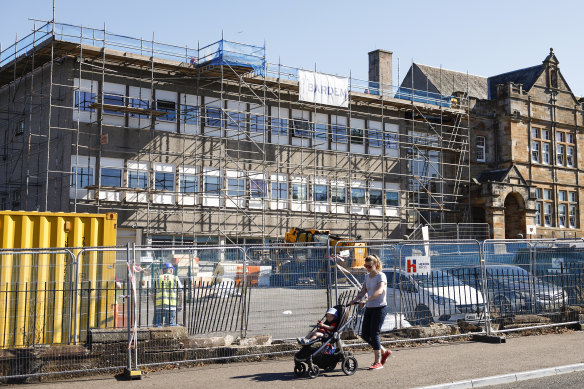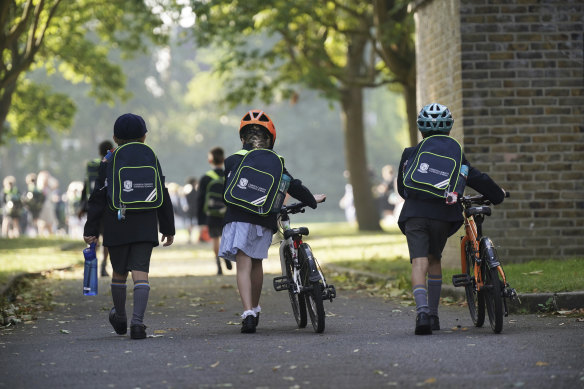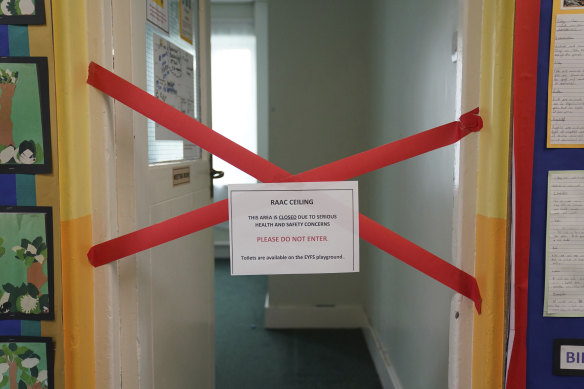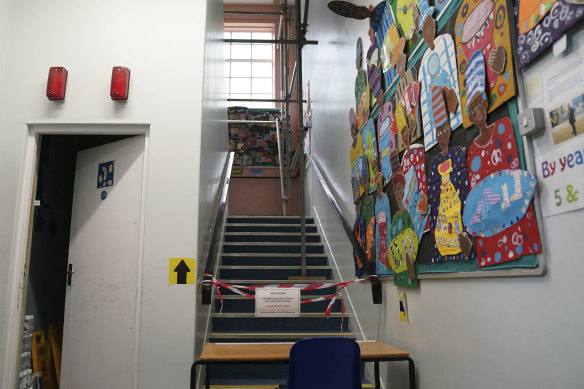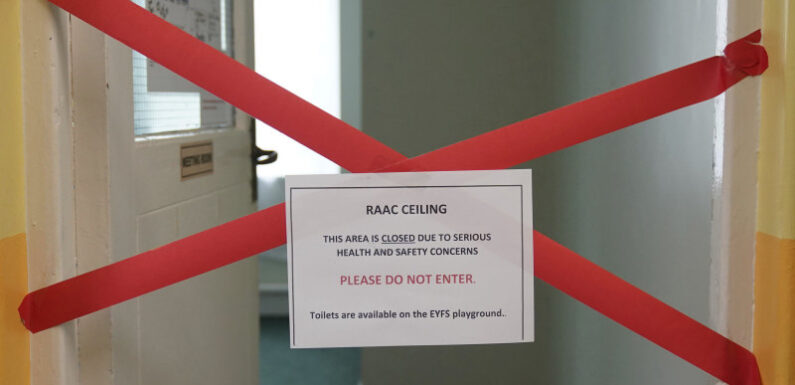
Save articles for later
Add articles to your saved list and come back to them any time.
London: Schools across England have been forced to close due to fears that the material used to build them decades ago – a cheaper, and weaker, alternative to traditional concrete – has deteriorated so badly that the buildings could collapse.
The closures sparked by the “concrete crisis”, as it has been dubbed by British media, coincide with the start of a new school year, meaning potentially thousands of pupils will need to be taught in temporary classrooms or online until the buildings are repaired.
The British government says at least 156 schools were built using RAAC or Reinforced Autoclaved Aerated Concrete, which has a life span of about 30 years. Last week, the national regulator for workplace health and safety said RAAC “is now life-expired. It is liable to collapse with little or no notice”.
A general view of scaffolding at Balbardie Primary School in Bathgate, Scotland. Councils across Scotland are reporting their schools have reinforced autoclaved aerated concrete (RAAC) in their buildingsCredit: Getty
On Monday, Secretary of State for Education Gillian Keegan told British media that 1500 schools were yet to respond to a survey on whether they have the form of concrete on their premises, stoking fears that the total number of schools affected could climb.
The material was used widely in construction of public buildings, including also hospitals, courts and police stations during the 1950s until the mid-1990s. Lighter than traditional concrete, it was used to build roofs but has also been found in walls and floors. RAAC panels and planks have a bubbly appearance and are softer than standard concrete.
Caroline Shaw, the former chief executive of Queen Elizabeth Hospital, described buildings built with it as an “Aero chocolate bar” and a “ticking time bomb” in 2018, the London Telegraph reported.
Pupils from Corpus Christi Catholic School, Brixton arrive at St Martin’s in the Field Girls’ School in London, as they are relocated after their school was found to be affected.Credit: PA/AP
RAAC becomes weaker and more prone to collapse as it ages. It is usually pale grey or white in appearance. It is made from lime, water and an aeration agent. Its decay is different to concrete cancer which is caused by rusting steel reinforcement.
The Standing Committee on Structural Safety (SCOSS), an independent body that identifies areas that could pose structural safety risks, warns that buildings made from the material carry risks and can collapse suddenly “with no apparent warning”.
The committee notes that while RAAC is often called concrete, it “is very different from traditional concrete and, because of the way in which it was made, much weaker.”
It is not yet clear for how long the affected schools will be closed. Some will only be forced to close certain areas of the building, depending on where the material has been identified.
The total cost of repairs at this stage is also unclear, schools minister Nick Gibb told British media, adding that it was hard to specify an exact figure. “In some schools it will just be a room or a cupboard,” he said, according to the Guardian. “In others it will be pervasive throughout.”
A taped off section inside Parks Primary School in Leicester, England.Credit: PA/AP
As the crisis rocks schools in England, risk assessments in Northern Ireland, Wales and Scotland are also taking place. The Telegraph reported more than 300 hospital buildings could be affected.
The British government said in a statement on Monday that it had been aware of the material being used in public sector buildings since 1994. It said it has been monitoring the issue since 2018 and helping schools to manage the risks through guidance and funding, noting that concerns grew over the northern summer.
“New cases have made us less confident that buildings containing RAAC should remain open without extra safety measures in place,” the statement said, adding that the partial or full closure of more than 100 schools was a “precautionary measure”.
Prime Minister Rishi Sunak said he understood the anxiety felt by families but wanted to stress that “a vast majority of schools are unaffected”. He also said that it was “completely and utterly wrong” to blame him for the crisis.
The British government has ordered more than 100 schools to keep some or all of their buildings closed for this week’s start of the new academic year.Credit: PA/AP
Schools Minister Gibb also downplayed the scale of the issue. “We’re talking about a small number of schools out of 22,500 schools,” Gibb said. “We have conducted surveys since March last year, so we know where RAAC is, and we’re sending in surveyors to identify RAAC.”
But Sunak critics say he and his government are not being transparent about the scale of the problem. Gibb said a full list of schools affected by RAAC would be published by Friday.
“Children are not at school today because of the action the government has failed to take in relation to schools. That is unforgivable,” leader of the Labour opposition party, Keir Starmer, said on Tuesday.
Signs that say “please do not enter” are already cropping up inside schools where RAAC poses a risk, forcing pupils to have their lessons taught elsewhere. Some parents are concerned about the possibility of their children returning to remote learning, which they experienced during the coronavirus pandemic.
In Essex, England, one school wrote to parents to notify them that at least 22 classrooms were found to have RAAC present and are currently unusable. Another school in West Yorkshire may not be able to fully operate until September 2025, one head teacher said, adding that more than half the building contained RAAC.
“[My daughter] has already been through the full pandemic at secondary school, her sister was as well, and it’s not good for their education, it’s not good for their mental health or their social skills,” one mother from London told the BBC.
The National education union, a British trade union for teachers and learning support staff, called the crisis “absolutely disgraceful”, writing that the closure of scores of schools just “a few days before the start of term” is “a sign of gross government incompetence”.
The organisation also expressed concern that many more buildings might be found to contain RAAC. “There are 156 schools with confirmed RAAC but how many more where it has not yet been identified?” it said.
The Washington Post
Most Viewed in World
From our partners
Source: Read Full Article
